
French postcard by A.N., Paris in the 'Les vedettes de cinéma' series, no. 30. Photo: Film Paramount.
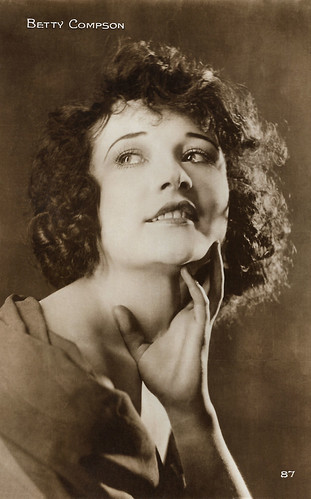
French postcard by Cinémagazine-Edition, no. 87.

Austrian postcard by Iris Verlag, no. 988. Photo: Universal Pictures Corporation. Betty Compson and Norman Kerry in Love Me and the World Is Mine (Ewald André Dupont, 1927).

British postcard in the Picturegoer Series, London, no. 196. Betty Compson in The Palace of Pleasure (Emmett J. Flynn, 1926) or in The Belle of Broadway (Harry O. Hoyt, 1926). Caption: Tivoli.
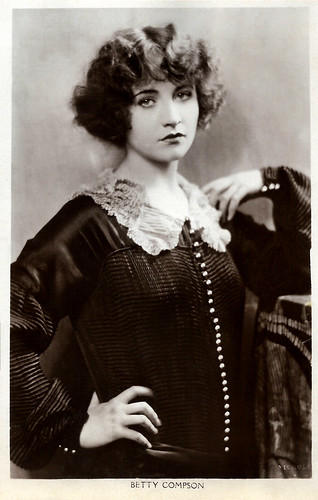
British postcard in the Picturegoer Series, London, no. 98. Photo: Nicholas (?).
The prettiest girl in pictures
Betty Compson was born Eleanor Luicime Compson in 1897 in Beaver, Utah at a mining camp. She was the daughter of Virgil K. Compson and Mary Elizabeth Rauscher. Her father was a mining engineer, a gold prospector, and a grocery store proprietor, and her mother was a maid in homes and in a hotel. A few months after she was born, her father seemingly deserted the family for the Klondike gold strike. As it turned out, he made $25,000 - a small fortune in today's terms - and returned to the family. Compson graduated from Salt Lake High School. Her father died when she was young and at 16 years old, she obtained employment as a violinist at a vaudeville theatre in Salt Lake City for $15 a week. Following that, she went on tour, with her mother, with an act called 'the Vagabond Violinist'.
In 1916, she appeared on the Alexander Pantages Theatre Circuit, again doing her violin solo vaudeville routine. There, the 18-year-old Compson was discovered by Hollywood producer Al Christie and she signed a contract with him. Christie quickly changed her stage name from Eleanor to Betty. Her first silent film was the short comedy Wanted, a Leading Lady (Al Christie, 1916), starring Eddie Lyons. In the following years, she appeared in many one-reel and two-reel slapstick comedies, frequently paired with Roscoe 'Fatty' Arbuckle. In 1916, she made 25 films - all of them were short comedies with the exception of one feature, Almost a Widow (Horace Davey, 1916). She continued making numerous short comedies well into the middle of 1918. Then, after her long apprenticeship with Christie, she started making features exclusively.
In 1919, Betty was signed by writer-director George Loane Tucker to co-star opposite Lon Chaney as Rose in The Miracle Man (George Loane Tucker, 1919). The film was a huge critical and financial success. Compson was called "The Prettiest Girl in Pictures". During the filming of Ladies Must Live (George Loane Tucker, 1921), Compson began a relationship with married director George Loane Tucker. However, Tucker was dying and as a favour to her, Tucker negotiated a contract with Paramount for her. Betty Compson signed a five-year contract with the studio. Her popularity allowed Compson to establish her own production company which provided her creative control over screenplays and financing. Her first film as a producer was Prisoners of Love (Art Rosson, 1921). She played the role of Blanche Davis, a girl born to wealth and cursed by her inheritance of physical beauty. The story was chosen from a work by actress and writer Catherine Henry.
After completing The Woman With Four Faces (Herbert Brenon, 1923), with Richard Dix, Paramount refused to offer her a raise (her salary was $2,500 per week) and she refused to sign without one. Instead, she signed with Balcon, Freedman & Saville, a film company in London, England. There she starred in a series of four films directed by Graham Cutts, a well-known English filmmaker. The first of these was a film version of an English play called Woman to Woman (Graham Cutts, 1923). The screenplay was co-written by Cutts and Alfred Hitchcock. She played a dual role in The White Shadow (Graham Cutts, 1924), also written by Alfred Hitchcock. Part of the film has been found and preserved from a collection in New Zealand. Woman to Woman was released in the United States and proved to be popular enough for Jesse Lasky to offer top dollar to return to Paramount.
Back in Hollywood, she starred in The Enemy Sex (1924), directed by James Cruze. Compson and Cruz married in 1924, but they had a rocky relationship and separated several times. One of the more highly paid performers of the silent screen, Compson's weekly earnings exceeded $5000 a week at the peak of her career. She came to own a fleet of luxury limousines and was able to move from a bungalow in the hills overlooking Hollywood to an expensive mansion on Hollywood Boulevard. In 1925, her contract with Paramount was not renewed and she decided to freelance, working with lower-budget studios such as Columbia Pictures in The Belle of Broadway (Harry O. Hoyt, 1926) and Chadwick in The Ladybird (Walter Lang, 1926), with Malcolm McGregor. During this time, she was suggested as a replacement for a difficult Greta Garbo in the MGM feature Flesh and the Devil (Clarence Brown, 1926), opposite John Gilbert. She eventually worked for the studio with former The Miracle Man co-star Lon Chaney in The Big City (Tod Browning, 1928).
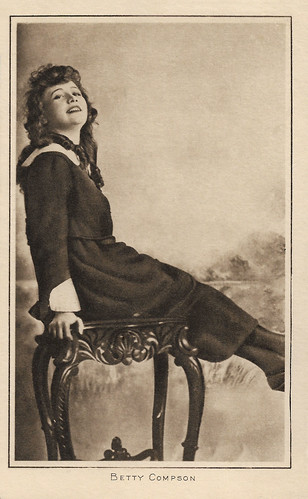
British postcard in the "Pictures" Portrait Gallery series, no. 66.

Spanish collectors card by Ed. Edoardo Pi, Barcelona.
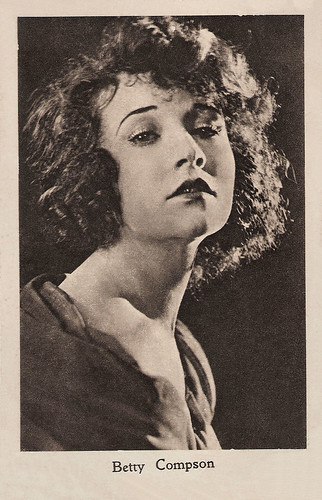
Spanish postcard for Fábrica de Chocolate de Evaristo Juncosa, Barcelona, by Huecograbado. Mumbrú, Barcelona, no. Serie A, no. 14. Collección de 14 postales Artistas Cinematograficos.

American promotion postcard for Alemite. Photo: Paramount. Collection: Marlene Pilaete.

American Arcade card by Exhibit Supply Co., Chicago, Ill. Photo: Paramount Pictures. Betty Compson, Lionel Belmore and William Collier Jr in Eve's Secrets (Clarence G. Badger, 1925).
The assistant of a demented ventriloquist
In 1928, Betty Compson appeared in a First National Pictures part-talkie, The Barker (George Fitzmaurice, 1928) opposite Milton Sills and Dorothy Mackaill. Her performance as manipulative carnival girl Carrie garnered her a nomination for the Academy Award for Best Actress. She lost to Mary Pickford in Coquette (Sam Taylor, 1929). In the silent film Court-Martial (George B. Seitz, 1928), she became the first actress to portray Old West outlaw Belle Starr on film. The film apparently has not survived. In the same year, she received good reviews in the highly acclaimed The Docks of New York (Josef von Sternberg, 1928) in a sympathetic portrayal of a suicidal prostitute rescued by stoker George Bancroft.
She gave a touching performance in The Great Gabbo (1929), directed by her then-husband James Cruze, as the assistant of a demented ventriloquist (Erich von Stroheim), with whom she is unhappily in love. That same year, she appeared in RKO's first sound film, Street Girl (Wesley Ruggles, 1929). These films caused Compson's popularity to re-emerge, and she became a busy actress in the new talking cinema. In fact, Chaney offered her the female lead in his first talkie The Unholy Three (Jack Conway, 1930), but she was too busy and instead suggested friend Lila Lee. Unlike a number of other female stars of silent film, it was felt that her voice recorded exceptionally well.
Although she was not a singer, she appeared in a number of early musicals, in which her singing voice was dubbed. She divorced James Cruze in 1930. The reason for their divorce was that Cruze had an addiction to alcohol and work, which put a strain on their marriage and his health. Soon after their divorce, Cruze filed for bankruptcy, and Compson was forced to sell her Hollywood villa, her cars and her antiques to pay past years' income taxes. However, Compson's career continued to flourish, and she starred in nine films in 1930 alone. Her last hit proved to be in The Spoilers (Edwin Carewe, 1930), alongside Gary Cooper. She was briefly under contract to RKO, and cast in so-called 'women's pictures' such as The Lady Refuses (George Archainbaud, 1931) and Three Who Loved (George Archainbaud, 1931) with Conrad Nagel.
She was unable to score a new success and only secured roles in 'poverty row' studios. One major film in which she did not appear was Gone with the Wind (Victor Fleming, 1939). Although she shot a Technicolor screen test for the role of Belle Watling, she was not cast in the role. In 1941, Compson appeared in a small role in the Hitchcock film Mr. & Mrs. Smith (Alfred Hitchcock, 1941), with Carole Lombard and Robert Montgomery. Most of her later films were low-budget, even exploitation, efforts. Her second marriage, to producer Irving Weinberg, lasted just four years, from 1933 to 1937. At their divorce trial, she testified that he left her home alone while he went out with other women. In 1944 she married professional boxer Silvius John Gall and decided to retire from Hollywood. Compson's last film was the comedy Here Comes Trouble (Fred Guiol, 1948).
After retiring from the screen, Betty Compson began a cosmetic line and helped her husband run a business named Ashtrays Unlimited, producing personalised ashtrays for the hospitality industry. Silvius Jack Gall died in 1962. All her marriages had been childless. Betty Compson died in 1974 of a heart attack at her home in Glendale, California, aged 77. She was interred in San Fernando Mission Cemetery in San Fernando, California. For her contributions to the motion picture industry, Betty Compson has a star on the Hollywood Walk of Fame at 1751 Vine Street.

German postcard by Ross Verlag, no. 1216/1. Photo: Arthur Ziehm. Written in Dutch on the card: 'De Revueprinses', which refers to Compson's film The Belle of Broadway (Harry O. Hoyt, 1926).
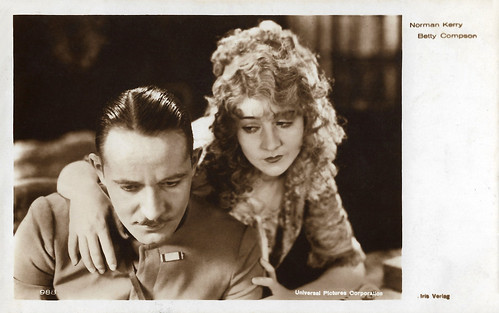
Austrian postcard by Iris Verlag, no. 988. Photo: Universal Pictures Corporations. Norman Kerry and Betty Compson in Love Me and the World Is Mine (Ewald André Dupont, 1927).

French postcard by Cinémagazine-Editions, no. 676. Photo: First National. Richard Barthelmess and Betty Compson in Weary River (Frank Lloyd, 1929).

Austrian postcard by Iris-Verlag, no. 365/1. Photo: Fanamet-Film.

Austrian postcard by Iris Verlag, no. 365/2. Photo: Paramount-Film.

Spanish minicard (collector's card). Series Intimidades cinematograficas, series I, card 18 of 20. Caption: The handshake of Betty Compson to real Indians who work as extras in cinema. According to the card, during the making of the Paramount film La horda maldita (The Cursed horde = The Thundering Herd, 1925), but Compson isn't in that film. It is more likely this refers to Compson's film The Pony Express (James Cruze, 1925).
Sources: I.S.Mowis (IMDb), Wikipedia and IMDb.
This post was last updated on 21 October 2023.
No comments:
Post a Comment